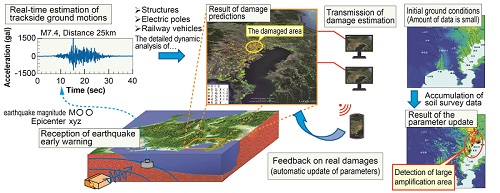1. Earthquake damage simulator for railways with self-correcting function
Rapid recovery of railway operations following an earthquake depends on being able to quickly obtain data about damage that has occurred. Until now, damage was estimated on the basis of seismic intensity observed through trackside seismographs and seismic damage nomographs, using the natural period and the yield acceleration of structures as parameters. This meant that obtaining more detailed damage estimation using local ground and structural characteristics, was difficult. This abstract introduces an earthquake damage simulator with a self-correcting function (Fig. 1). Simulation begins automatically when an Earthquake Early Warning is received. The simulator processes the information available at that moment (epicenter, seismic observation records, etc.) and predicts trackside seismic waveforms in real time. The simulator can estimate damage through detailed dynamic analyses of the behavior of structures, electric poles and railway vehicles using the seismic waveforms.
Using the simulator, damage can be estimated within several minutes to several tens of minutes taking into account the difference of in characteristics of deep soil structures, the surface ground and vibration characteristics of each railway structure. An algorithm automatically updates the parameters in the simulator used for estimating damage by adding information, such as boring survey data and structural design sheets, and observed ground motion. As a result, damage estimation can automatically improve with as damage and earthquake data is collected and accumulated.
Generally, increasing simulation accuracy requires longer calculation time. This simulator however, manages to combine high precision and immediacy thanks to the self-correction function and ranking of structures in order of priority for inspection, thereby allowing operations to resume more quickly following an earthquake.
This research was financially supported by the Ministry of Land, Infrastructure, Transport and Tourism.
Other Contents
- 1. Earthquake damage simulator for railways with self-correcting function
- 2. Practical application of early earthquake warning method using ocean bottom seismometer data
- 3. Countermeasures to prevent subsidence of abutment backfill and track buckling during earthquakes
- 4. Ground surface layer response evaluation method for very large earthquakes
- 5. Anti-seismic reinforcement method for suspended-ceilings with small cavities at stations
- 6. Algorithm to estimate strong wind locations due to such as gusts.
- 7. Flowchart to determine possibility of reusing bridge following scouring damage
- 8. Increase in accuracy of bogie hunting stability evaluation
- 9. Driver visual recognition support method using image processing
- 10. Health monitoring of very large structures using long-range U-Doppler
- 11. Influence of pinion shaft bearing endplay (axial clearance) on its seizure initiation
- 1. Earthquake damage simulator for railways with self-correcting function
- 2. Practical application of early earthquake warning method using ocean bottom seismometer data
- 3. Countermeasures to prevent subsidence of abutment backfill and track buckling during earthquakes
- 4. Ground surface layer response evaluation method for very large earthquakes
- 5. Anti-seismic reinforcement method for suspended-ceilings with small cavities at stations
- 6. Algorithm to estimate strong wind locations due to such as gusts.
- 7. Flowchart to determine possibility of reusing bridge following scouring damage
- 8. Increase in accuracy of bogie hunting stability evaluation
- 9. Driver visual recognition support method using image processing
- 10. Health monitoring of very large structures using long-range U-Doppler
- 11. Influence of pinion shaft bearing endplay (axial clearance) on its seizure initiation

